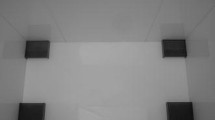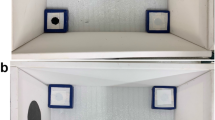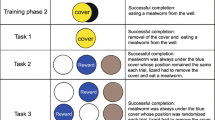Abstract
When trained in a rectangular arena, some research has suggested that rats are guided by local features rather than overall boundary geometry. We explored this hypothesis using the terrestrial toad, Rhinella arenarum, as a comparative contrast. In two experiments, toads were trained to find a water-reward goal location in either a featureless rectangular arena (Experiment 1) or in a rectangular arena with a removable colored feature panel covering one short wall (Experiment 2). After learning to successfully locate the water reward, probe trials were carried out by changing the shape of the arena into a kite form with two 90°-angled corners, and in the case of Experiment 2, also shifting the location of the color panel. The results of Experiment 1 indicated that the toads, in contrast to rats, relied primarily on overall shape or boundary geometry to encode the location of a goal. Under the probe conditions of the altered environmental geometry in Experiment 2, the toads seemed to preferentially choose a corner that was generally correct relative to the feature panel experienced during training. Together, the data of the current study suggest that toads and rats differ in the strategies they employ to represent spatial information available in a rectangular arena. Further, the results support the hypothesis that amphibians and mammals engage different neural mechanisms, perhaps related to different evolutionary selective pressures, for the representation of environmental geometry used for navigation.




Similar content being viewed by others
References
Ambosta AH, Reichert JF, Kelly DM (2013) Reorienting in virtual 3D environments: do adult humans use principal axes, medial axes or local geometry? PLoS One 8(11):1–12. https://doi.org/10.1371/journal.pone.0078985e78985
Batty ER, Bloomfield LL, Spetch ML, Sturdy CB (2009) Comparing black-capped Poecile atricapillus and mountain chickadees Poecile gambeli: use of geometric and featural information in a spatial orientation task. Anim Cogn 12:633–641. https://doi.org/10.1007/s10071-009-0222-3
Benhamou S, Poucet B (1998) Landmark use by navigating rats (Rattus norvegicus) contrasting geometric and featural information. J Comp Psychol 112(3):317–322. https://doi.org/10.1037/0735-7036.112.3.317
Bingman VP, Muzio RN (2017) Reflections on the structural-functional evolution of the hippocampus: what is the big deal about a dentate gyrus? Brain Behav Evolut 90:53–61. https://doi.org/10.1159/000475592
Bisazza A, Cantalupo C, Robins A, Rogers LJ, Vallortigara G (1996) Right-pawedness in toads. Nature 379:408. https://doi.org/10.1038/379408a0
Bodily KD, Sullens DG, Price SJ, Sturz BR (2018) Testing principal-versus medial-axis accounts of global spatial reorientation. J Exp Psychol Anim L 44(2):209–215. https://doi.org/10.1037/xan0000162
Chamizo VD, Manteiga RD, Rodrigo T, MacKintosh NJ (2006) Competition between landmarks in spatial learning: the role of proximity to the goal. Behav Process 71:59–65. https://doi.org/10.1016/j.beproc.2005.11.003
Cheng K (1986) A purely geometric model in rat’s spatial representation. Cognition 23:149–178. https://doi.org/10.1016/0010-0277(86)90041-7
Cheng K, Gallistel CR (2005) Shape parameters explain data from spatial transformations: comment on Pearce et al. (2004) and Tommasi & Polli (2004). J Exp Psychol Anim B 31(2):254–259. https://doi.org/10.1037/0097-7403.31.2.254
Cheng K, Shettleworth SJ, Huttenlocher J, Rieser JJ (2007) Bayesian integration of spatial information. Psychol Bull 133:625–637. https://doi.org/10.1037/0033-2909.133.4.625
Cheng K, Huttenlocher J, Newcombe N (2013) 25 years of research on the use of geometry in spatial reorientation: a current theoretical perspective. Psychon B Rev 20:1033–1054. https://doi.org/10.3758/s13423-013-0416-1
Dall SR, Houston AI, McNamara JM (2004) The behavioural ecology of personality: consistent individual differences from an adaptive perspective. Ecol Lett 7(8):734–739. https://doi.org/10.1111/j.1461-0248.2004.00618.x
Daneri MF, Casanave EB, Muzio RN (2011) Control of spatial orientation in terrestrial toads (Rhinella arenarum). J Comp Psychol 125(3):296–307. https://doi.org/10.1037/a0024242
Freeman MF, Tukey JW (1950) Transformations related to the angular and the square root. Ann Math Stat 21(4):607–611. https://doi.org/10.1214/aoms/1177729756
Gallistel CR (1990) The organization of learning. MIT Press, Cambridge
Gosling SD (2001) From mice to men: what can we learn about personality from animal research? Psychol Bull 127:45–86. https://doi.org/10.1037/0033-2909.127.1.45
Gouteux S, Spelke ES (2001) Children’s use of geometry and landmarks to reorient in an open space. Cognition 81:119–148. https://doi.org/10.1016/S0010-0277(01)00128-7
Gray ER, Bloomfield LL, Ferrey A, Spetch ML, Sturdy CB (2005) Spatial encoding in mountain chickadees: Features overshadow geometry. Biol Lett 1(3):314–317. https://doi.org/10.1098/rsbl.2005.0347
Hermer L, Spelke ES (1994) A geometric process for spatial reorientation in young children. Nature 370:57–59. https://doi.org/10.1038/370057a0
Hermer L, Spelke E (1996) Modularity and development: the case of spatial reorientation. Cognition 61:195–232. https://doi.org/10.1016/S0010-0277(96)00714-7
Hermer-Vazquez L, Spelke ES, Katsnelson AS (1999) Sources of flexibility in human cognition: dual-task studies of space and language. Cogn Psychol 39:3–36. https://doi.org/10.1006/cogp.1998.0713
Horne MR, Iordanova MD, Pearce JM (2010) Spatial learning based on boundaries in rats is hippocampus-dependent and prone to overshadowing. Behav Neurosci 124(5):623–632. https://doi.org/10.1037/a0020824
Hupbach A, Nadel L (2005) Reorientation in a rhombic environment: no evidence for an encapsulated geometric module. Cogn Dev 20:279–302. https://doi.org/10.1016/j.cogdev.2005.04.003
Huttenlocher J, Hedges LV, Duncan S (1991) Categories and particulars: prototype effects in estimating spatial location. Psychol Rev 98:352–376. https://doi.org/10.1037/0033-295X.98.3.352
IUCN (2014). International union for conservation of nature and natural resources red list of threatened species. Version 2014.3. IUCN, Cambridge
Kelly DM, Spetch ML, Heth CD (1998) Pigeons’ (Columba livia) encoding of geometric and featural properties of a spatial environment. J Comp Psychol 112:259–269. https://doi.org/10.1037/0735-7036.112.3.259
Kelly DM, Chiandetti C, Vallortigara G (2010) Re-orienting in space: do animals use global or local geometry strategies? Biol Lett 7:372–375. https://doi.org/10.1098/rsbl.2010.1024
Kesner RP (2013) Role of the hippocampus in mediating interference as measured by pattern separation processes. Behav Process 93:148–154. https://doi.org/10.1016/j.beproc.2012.09.018
Lee SA, Sovrano VA, Spelke ES (2012) Navigation as a source of geometric knowledge: young children’s use of length, angle, distance, and direction in a reorientation task. Cognition 123:144–161. https://doi.org/10.1016/j.cognition.2011.12.015
Leutgeb JK, Leutgeb S, Moser MB, Moser EI (2007) Pattern separation in the dentate gyrus and CA3 of the hippocampus. Science 315:961–966. https://doi.org/10.1126/science.1135801
Lever C, Burton S, Jeewajee A, O’Keefe J, Burgess N (2009) Boundary vector cells in the subiculum of the hippocampal formation. J Neurosci 29(31):9771–9777. https://doi.org/10.1523/JNEUROSCI.1319-09.2009
Lew AR, Gibbons B, Murphy C, Bremner JG (2010) Use of geometry for spatial reorientation in children applies only to symmetric spaces. Dev Sci 13:490–498. https://doi.org/10.1111/j.1467-7687.2009.00904.x
Lippolis G, Bisazza A, Rogers LJ, Vallortigara G (2002) Lateralisation of predator avoidance responses in three species of toads. Later Asymmetries Body Brain Cogn 7:163–183. https://doi.org/10.1080/13576500143000221
Liu Y, Burmeister SS (2017) Sex differences during place learning in the túngara frog. Anim Behav 128:61–67. https://doi.org/10.1016/j.anbehav.2017.04.002
Liu Y, Day LB, Summers K, Burmeister SS (2016) Learning to learn: advanced behavioral flexibility in a poison frog. Anim Behav 111(1):167–172. https://doi.org/10.1016/j.anbehav.2015.10.018
Lourenco SF, Cabrera J (2015) The potentiation of geometry by features in human children: evidence against modularity in the domain of navigation. J Exp Child Psychol 140:184–196. https://doi.org/10.1016/j.jecp.2015.07.007
McDonald JH (2014) Handbook of biological statistics, 3rd edn. Sparky House Publishing, Baltimore
McGregor A, Hayward AJ, Pearce JM, Good MA (2004) Hippocampal lesions disrupt navigation based on the shape of the environment. Behav Neurosci 118:1011–1021. https://doi.org/10.1037/0735-7044.118.5.1011
Muzio RN, Segura ET, Papini MR (1992) Effect of schedule and magnitude of reinforcement on instrumental acquisition and extinction in the toad, Bufo arenarum. Learn Motiv 23:406–429. https://doi.org/10.1016/0023-9690(92)90004-6
Muzio RN, Pistone Creydt V, Iurman M, Rinaldi M, Sirani B, Papini MR (2011) Incentive or habit learning in amphibians? PLoS One 6(11):1–12. https://doi.org/10.1371/journal.pone.0025798(e25798)
Nardi D, Bingman VP (2009) Pigeon (Columba livia) encoding of a goal location: the relative importance of shape geometry and slope information. J Comp Psychol 123:204–216. https://doi.org/10.1037/a0015093
Nardi D, Nitsch KP, Bingman VP (2010) Slope-driven goal location behavior in pigeons. J Exp Psychol Anim B 36:430–442. https://doi.org/10.1037/a0019234
National Research Council (2011) Guide for the care and use of laboratory animals, 8th edn. National Academies Press, Washington, DC
Newcombe NS, Ratliff KR (2007) Explaining the development of spatial reorientation: modularity-plus-language versus the emergence of adaptive combination. In: Plumert JM, Spencer JP (eds) The emerging spatial mind. Oxford University Press, New York, pp 63–76
Newcombe NS, Ratliff KR, Shallcross WL, Twyman AD (2010) Young children’s use of features to reorient is more than just associative: further evidence against a modular view of spatial processing. Dev Sci 13:213–220. https://doi.org/10.1111/j.1467-7687.2009.00877.x
O’Keefe J, Nadel L (1978) The hippocampus as a cognitive map. Clarendon Press, Oxford
O’Keefe J, Burgess N (1996) Geometric determinants of the place fields of hippocampal neurons. Nature 381:425–428. https://doi.org/10.1038/381425a0
Pearce JM, Aydin A (2001) Influence of a beacon on spatial learning based on the shape of the test environment. J Exp Psychol Anim B 7(4):329–344. https://doi.org/10.1037/0097-7403.27.4.329
Pearce JM, Good MA, Jones PM, McGregor A (2004) Transfer of spatial behavior between different environments: implications for theories of spatial learning and for the role of the hippocampus in spatial learning. J Exp Psychol Anim B 30(2):135–147. https://doi.org/10.1037/0097-7403.30.2.135
Pearce JM, Graham M, Good MA, Jones PM, McGregor A (2006) Potentiation, overshadowing, and blocking of spatial learning based on the shape of the environment. J Exp Psychol Anim B 32(3):201–214. https://doi.org/10.1037/0097-7403.32.3.201
Pecchia T, Vallortigara G (2010a) Reorienting strategies in a rectangular array of landmarks by domestic chicks (Gallus gallus). J Comp Psychol 124:147–158. https://doi.org/10.1037/a0019145
Pecchia T, Vallortigara G (2010b) View-based strategy for reorientation by geometry. J Exp Biol 213:2987–2996. https://doi.org/10.1242/jeb.043315
Puddington MM, Papini MR, Muzio RN (2013) Vulnerability of long-term memory to temporal delays in amphibians. Behav Process 99:7–11. https://doi.org/10.1016/j.beproc.2013.05.010
Ruibal R (1962) The adaptive value of bladder water in the toad (Bufo cognatus). Physiol Zool 35:218–223. https://doi.org/10.1086/physzool.35.3.30152806
Sheynikhovich D, Chavarriaga R, Strösslin T, Arleo A, Gerstner W (2009) Is there a geometric module for spatial orientation? Insights from a rodent navigation model. Psychol Rev 116(3):540–566. https://doi.org/10.1037/a0016170
Sotelo MI, Bingman VP, Muzio RN (2015) Goal orientation by geometric and feature cues: spatial learning in the terrestrial toad Rhinella arenarum. Anim Cogn 18:315–323. https://doi.org/10.1007/s10071-014-0802-8
Sotelo MI, Daneri MF, Bingman VP, Muzio RN (2016) Telencephalic neuronal activation associated with spatial memory in the terrestrial toad Rhinella arenarum: participation of the medial pallium during navigation by geometry. Brain Behav Evolut 88(3–4):149–160. https://doi.org/10.1159/000447441
Sotelo MI, Bingman VP, Muzio RN (2017) Slope-based and geometric encoding of a goal location by the terrestrial toad (Rhinella arenarum). J Comp Psychol 131(4):362–369. https://doi.org/10.1037/com0000084
Sotelo MI, Nardi D, Payne KB, Coppola V, Muzio RN, Bingman VP (2019) Local geometry properties do not support reorientation in hippocampus-engaged homing pigeons. Behav Neurosci 133(2):255–264. https://doi.org/10.1037/bne0000298
Stancher G, Rugani R, Regolin L, Vallortigara G (2015) Numerical discrimination by frogs (Bombina orientalis). Anim Cogn 18:219–229. https://doi.org/10.1007/s10071-014-0791-7
Sturz BR, Gurley T, Bodily KD (2011) Orientation in trapezoid-shaped enclosures: implications for theoretical accounts of geometry learning. J Exp Psychol Anim B 37:246–253. https://doi.org/10.1037/a0021215
Sturz BR, Forloines MR, Bodily KD (2012) Enclosure size and the use of local and global geometric cues for reorientation. Psychon B Rev 19(2):270–276. https://doi.org/10.3758/s13423-011-0195-5
Uher J (2008) Comparative personality research: methodological approaches. Eur J Personal 22:427–455. https://doi.org/10.1002/per.680
Vallortigara G, Zanforlin M, Pasti G (1990) Geometric modules in animals’ spatial representations: a test with chicks (Gallus gallus domesticus). J Comp Psychol 104:248–254. https://doi.org/10.1037/0735-7036.104.3.248
Vallortigara G, Rogers LJ, Bisazza A, Lippolis G, Robins A (1998) Complementary right and left hemifield use for predatory and agonistic behaviour in toads. NeuroReport 9:3341–3344. https://doi.org/10.1097/00001756-199810050-00035
Vargas JP, López JC, Salas C, Thinus-Blanc C (2004) Encoding of geometric and featural spatial information by goldfish (Carassius auratus). J Comp Psychol 118:206–216. https://doi.org/10.1037/0735-7036.118.2.206
Wagenmakers E-J, Wetzels R, Borsboom D, van der Maas HLJ (2011) Why psychologists must change the way they analyze their data: the case of psi: comment on Bem (2011). J Pers Soc Psychol 100:426–432. https://doi.org/10.1037/a0022790
Wystrach A (2009) Ants in rectangular arenas: a support for the global matching theory. Commun Integr Biol 2:388–390. https://doi.org/10.4161/cib.2.5.8717
Wystrach A, Beugnon G (2009) Ants learn geometry and features. Curr Biol 19:61–66. https://doi.org/10.1016/j.cub.2008.11.054
Wystrach A, Cheng K, Sosa S, Beugnon G (2011) Geometry, features, and panoramic views: ants in rectangular arenas. J Exp Psychol Anim B 37:420–435. https://doi.org/10.1037/a0023886
Funding
This research was funded in part by Grant PICT 4300 (FONCYT), by Grant PIP 0893 (CONICET), and by Grant UBACYT P0068BA (Universidad de Buenos Aires), Argentina, all to RNM. VPB was funded by NSF Grant IOS-1457304 during the carrying out of the study. JAAM participation was supported by mobility program of Asociación Universitaria Iberoamericana de Postgrado (AUIP).
Author information
Authors and Affiliations
Corresponding author
Ethics declarations
Ethical approval
Animal procedures were authorized under Institutional Animal Care and Use Committee (IACUC) protocol 035/2016 IBYME-CONICET, Argentina.
Additional information
Publisher's Note
Springer Nature remains neutral with regard to jurisdictional claims in published maps and institutional affiliations.
Rights and permissions
About this article
Cite this article
Sotelo, M.I., Alcalá, J.A., Bingman, V.P. et al. On the transfer of spatial learning between geometrically different shaped environments in the terrestrial toad, Rhinella arenarum. Anim Cogn 23, 55–70 (2020). https://doi.org/10.1007/s10071-019-01315-9
Received:
Revised:
Accepted:
Published:
Issue Date:
DOI: https://doi.org/10.1007/s10071-019-01315-9




